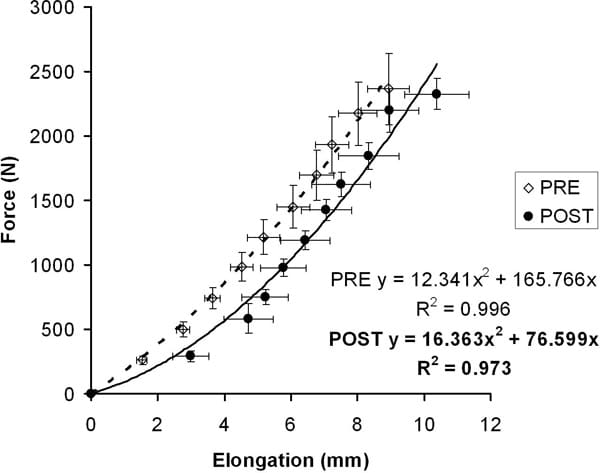Collagen protein is ubiquitous in connective tissue, including tendons and there is reason to believe that Eicosapentaenoic acid (EPA), the main acting agent in Omega-3 therapy (O3T), may alter collagen protein synthetic response and thus influence tendon mechanical properties. Indeed EPA has been associated with increased collagen and elastic fibres expression in aged human skin (Kim et al, 2006). O3T has also been used to address ageing associated decreases in range of motion and increased joint pain (Gruenwald et al, 2002). It is unclear however whether the effects of O3T on the joints are merely increased lubrication or whether the therapy has any direct effect on the intrinsic properties of the collagenous tissues around the affected joint. We therefore investigated whether a 12-week course of oral O3T (three 1g pills taken in the pre-prandial state daily, each containing 180mg EPA) would have an effect of the structural and mechanical properties of the patellar tendon. Subjects: Nine healthy, community-living participants (age 77±1years, height 1.65±0.02m, weight 74±4Kg), gave their consent to participate in this study which was approved by the local Institutional Ethics Committee. All procedures accorded with the principles of the World Medical Association’s Declaration of Helsinki. A combination of isokinetic dynamometry, electromyography, B-mode ultrasound imaging and magnetic resonance imaging were used to assess tendon properties using a method previously described (Onambele et al, 2007). Pre – post O3T comparisons were performed using paired student t-test. Tendon dimensions of length (4.52±0.17cm pre vs. 4.48±0.24cm post, P>0.05), and cross-sectional area (76.8±8.9 mm2 pre vs. 76.5±8.9 mm2 post, P>0.05) did not change with O3T. Maximal voluntary isometric force capacity also did not show any changes (2390±245N pre vs. 2327±121N post, P>0.05). Interestingly however, there was a 28% (P<0.0001) increment in tendon elongation during voluntary contractions (see Figure 1), which translated into a 14% (P=0.015) decrement in tendon stiffness. → Figure 1 near here The present study demonstrates that 12 weeks of Omega-3 supplementation in elderly subjects alters the viscoelastic properties of the human patella tendon. It is as yet unclear whether this is a positive physiological outcome in a context where ageing is normally associated with decreased tendon stiffness and the associated decreased ability to maintain adequate functional abilities such as stable standing posture (Onambele et al, 2006).
Life Sciences 2007 (2007) Proc Life Sciences, PC570
Poster Communications: Association of Omega-3 therapy with changes in tendon structural properties in healthy older adults
S. J. Pearson2, L. Breen1, K. E. Burgess2, C. E. Stewart1, G. L. Onambele-Pearson1
1. IRM, Manchester Metropolitan University, Alsager, United Kingdom. 2. CRHPR, Directorate of Sport, University of Salford, Manchester, United Kingdom.
View other abstracts by:
Figure 1. Tendon force-elongation relationship with omega-3 therapy. Data are mean±SEM.
Where applicable, experiments conform with Society ethical requirements.

